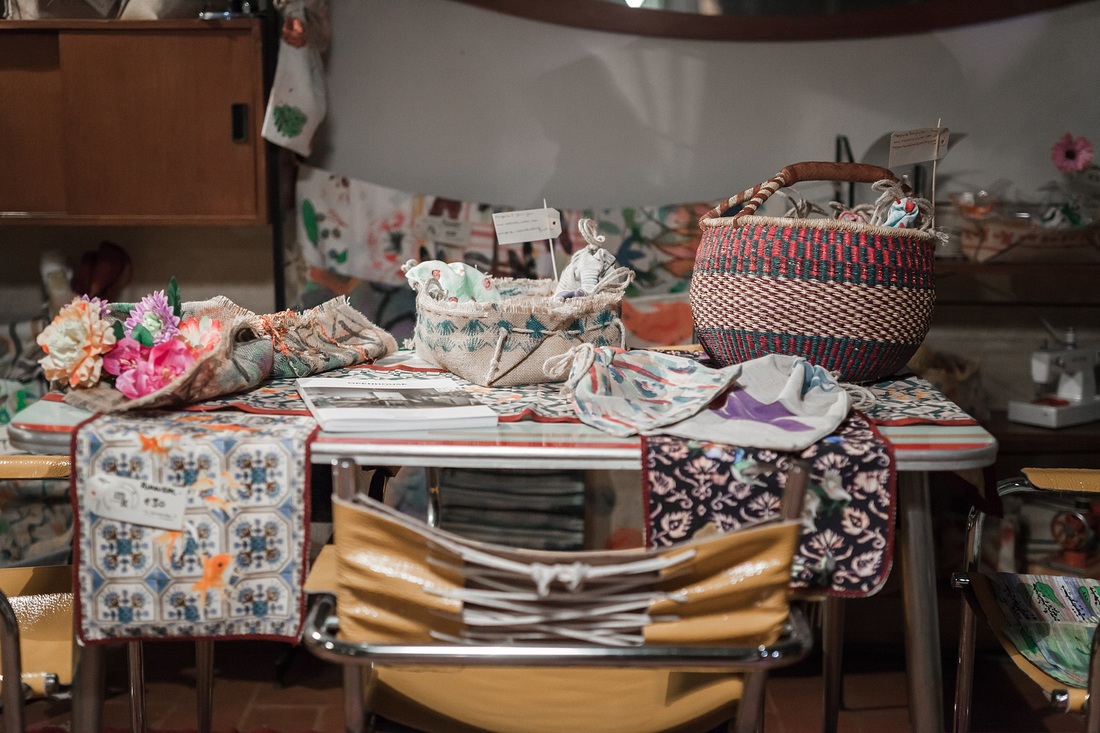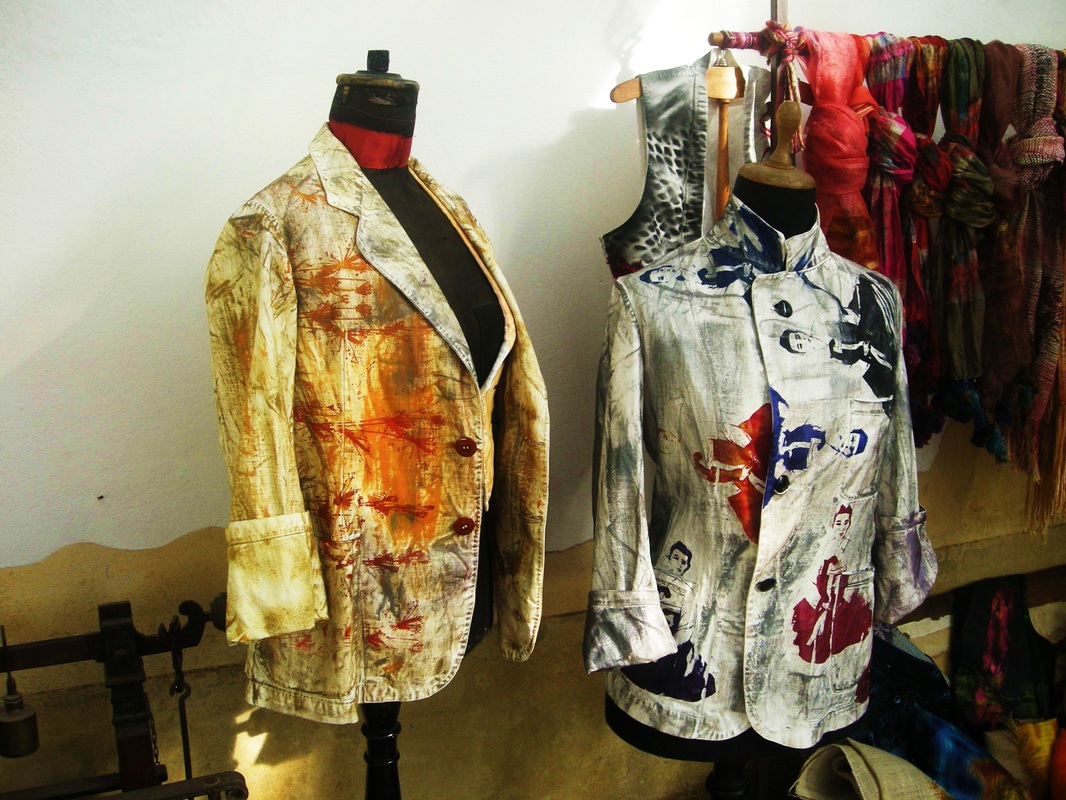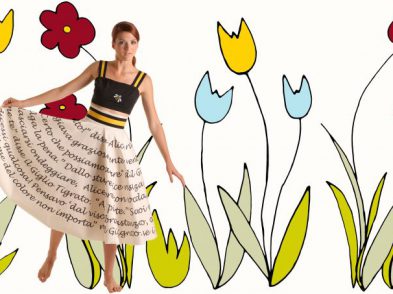MK Textiles was born, quite literally, from a greenhouse in central Florence. Creators Margherita Pandolfini and Karl Jorns attribute their collection to the space that they have collectively cultivated and curated. Over the past seven years they’ve built a studio that lives and breathes as much as you or I and they won’t mention the studio or the products without the other in the same sentence. It’s a symbiotic relationship both between Margherita and Karl and the atelier and its products. Whether it’s opening the studio to host events or other artists, designing special-edition textiles for Bergdorf Goodman or creating custom projects for the Saudi Prince, it’s clear that this Florence-based atelier is giving life to some major projects.

Alexandra Olivo: Tell me a little bit about your brand, for example, what types of textiles do you mainly create?
Margherita Pandolfini: We mainly do homewares and accessories but for Pitti Uomo we’ve done some handbags and scarves. Apart from just the products themselves, our philosophy is linked to the studio where the products are made, the space of the atelier, Karl and I working together and blending both our different backgrounds. So it’s the whole package. MK isn’t just printed textiles, it’s everything together.
Karl Jorns: It’s a fusion of everything. They are unique pieces, hand numbered. They are usually one of a kind. We don’t want to do huge productions. Whether digital or hand painted, they have to be small quantities. We guarantee that they are going to be limited edition.
MP: Well, we’ve also sold to Bergdorf Goodman so when we’ve had specific orders, of course, we could do something like 50 pieces. But normally our own collection is limited to a few pieces.
KJ: Even with Bergdorf Goodman there were 18 pieces with each pattern, no more than that. With Burning Man [a special project for the Saudi Prince, Prince Fahad Alsaud], it was one piece. We do many projects but above all we do textiles; digitally printed, hand painted and screened.
AO: I understand that space can be extremely influential in the creative process. Talk me through the interior design of your atelier.
MP: We’ve been working together since 2009 so the space and the products have changed and developed throughout the years. We haven’t updated it for a few months now but when Karl and I get bored we change it. The color changes, the products change.
KJ: The furniture, everything, it’s always growing. We use things bought at flea markets or objects borrowed from my own space, as well as pieces from family furniture that people bring to us. We work with all of them.
AO: Would you say that the space or the product is more important?
MP: They are the same.
KJ: The space is a greenhouse so everything, the product, grows there. If you see the place you can understand, it’s amazing. It makes you create beautiful pieces. We’ve done fabric panels, we’ve redone vintage furniture, a little bit of everything. Then we started working with tote bags, always one of a kind and hand painted. We use leathers and special materials like vintage buckles. We painted 1930’s vintage waiter jackets. We are always trying to make unique pieces.
AO: Where did you find the space?
MP: It’s part of my family’s home, Palazzo Pandolfini. It’s been in the family for many centuries, since the beginning. The greenhouse, the downstairs bit, wasn’t always there. It was built for one of my ancestors because she liked camellias so her husband had a greenhouse built.
AO: How did the two of you meet?
MP and KJ (in unison): In London.
KJ: We knew of each other, with my being in Florence and Margherita being in Rome and London. We had heard about each other and we finally met while working on a project together, the opening of a boutique. We started talking and decided that maybe it was not the right moment to start working together, but when we met one month later we started chatting again.
MP: We just wanted to work together and the products just kind of developed.

AO: Why did you choose to open your atelier to other artists?
KJ: It’s a way of renewing yourself and your ideas. It’s also about sharing our space and part of ourselves. It’s like when you share your time with friends. People can know us and we can know other people. We try to give to others the same opportunity that we have: to know the space.
AO: Tell me about some of your recent or upcoming projects.
MP: We recently designed a collection of placemats for a boutique hotel called Florence Factory here in Florence. And of course there are the events we host at the studio. Then there were the Bergdorf Goodman orders last year in autumn and in spring. We’ve also recently done some costumes for a contemporary dance festival here in Florence. We’re about to do some cushions for a hostel in Rome and a line of table runners for a wine bar.
For the Saudi Prince we also recently did his family’s house in London, we redecorated it. Then we also did his tents for Burning Man Festival, those were kind of Moroccan themed. I believe there were four tents in total, two large and two small, plus a lot of throw pillows. We hand painted all the tents and the cushions. We hand painted the panels here in Florence and brought them to Los Angeles. I like doing bigger projects, site specific work like the tents. I’d like to do more of those types of projects, maybe a restaurant or a hotel, designing for a space. I’d like to see our projects living in a space.
AO: Why did you choose Florence?
MP: My family lives here, Karl’s been teaching here forever and because of the space. This is where the greenhouse is. Even when I travel now I realize that this space, what we’ve got here, I could never find anywhere else.
AO: I want to finish the interview by coming back to the studio. I’m fascinated with the space that you’ve created and how it manifests in your designs. The relationship seems very intricate but if you could put it into a sentence to explain to people how your space and your designs interact, what would it be?
KJ: It’s everything. We change the studio as you change your clothes. It needs to show who we are, our mood, our work, our desires, everything. The studio is like a part of us. It gives energy to us, it gives inspiration. It’s alive.
After talking with Margherita and Karl and visiting the atelier it is easy to see why they are so passionate about their space. The greenhouse, perched on the second floor of the Palazzo Pandolfini, overlooks the gardens. It is certainly a creative center but one that is meticulously crafted. Everything has its place: there are no crazy cluttered messes inside the atelier. Instead, it is a place of serenity. With the wind gently blowing the curtains open to reveal the lawn below and the sun streaming through the glass, it seems that the atelier just might be alive after all.
About Fashion in Florence
In May-June 2017 ISI (International Studies Institute of Florence) will offer for the third time an innovative class in Fashion Communication for non-specialized students in design. Emphasis will be on analysis of leading fashion media critics, commentators, bloggers and influencers. During the last edition of the course students had the opportunity to visit Pitti Uomo fashion trade-fair and write their reports and blogs including one-on-one interviews with leading young figures in Fashion in Florence. Professor Emeritus Mark Bernheim headed the team, which included fashion commentator Alessandro Masetti.





